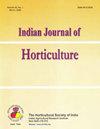芒果杂交种及其亲本在活力、开花、产量成分和生化性状方面的表征
Q4 Agricultural and Biological Sciences
引用次数: 0
摘要
对包括亲本 "Amrapali "和 "Sensation "在内的 70 个芒果杂交种的活力、开花、产量和生化特性进行了评估。杂交种'H-13-5'的株高最大(10.11 米),'H-1-6'的茎围最大(132.21 厘米),'H-13-1'的冠幅最大(9.77 米)。杂交种'H-13-4'的树皮木材比最高(7.59),表明整个茎干周围的成熟木材比例较高。杂交种'H-1-9'的气孔密度最高(797 个气孔/平方毫米),这是一种矮化性状。在繁殖特性方面,杂交种'H-11-4'每圆锥花序结出的果实数最多(2.51 个)。杂交种'H-11-1'的留果率为 62%,表现出更高的留果率。果实产量较高的杂交种'H-1-8'每棵树的果实产量为 43 公斤。杂交种'H-1-5'结出的果实最大(每个果实 317 克)。这些结果表明,杂交种因其有利的经济性状,在未来的育种和商业开发方面具有很大的潜力。本文章由计算机程序翻译,如有差异,请以英文原文为准。
Characterization of mango hybrids and their parents for vigor, flowering, yield components and biochemical traits
The vigour, blooming, yield, and biochemical features of seventy mango hybrids, including their parents,‘Amrapali’ and ‘Sensation’, were evaluated. The hybrid ‘H-13-5’ had the greatest plant height (10.11m), wherestem girth was maximum in ‘H-1-6’ (132.21cm), and ‘H-13-1’ had the largest canopy spread (9.77 m). The hybrid‘H-13-4’ exhibited the highest bark-wood ratio (7.59), signifying a higher percentage of mature wood surroundingthe entire stem. Hybrid ‘H-1-9’ had the highest stomatal density (797 stomata/mm2) as a dwarfing trait. Regardingreproductive characteristics, hybrid ‘H-11-4’ produced the maximum number of fruits (2.51) per panicle. Witha more significant fruit retention percentage of 62%, the hybrid ‘H-11-1’ showed improved fruit retention onthe tree. The tree with the higher fruit output, hybrid ‘H-1-8’, produced 43 kg of fruit per tree. The hybrid ‘H-1-5’ produced the maximum size of fruits (317 g/ per fruit). These signify that the resultant hybrids have a lotof potential for future breeding and commercial exploitation be cause of their advantageous economic traits
求助全文
通过发布文献求助,成功后即可免费获取论文全文。
去求助
来源期刊

Indian Journal of Horticulture
农林科学-园艺
CiteScore
0.50
自引率
0.00%
发文量
22
审稿时长
4-8 weeks
期刊介绍:
Information not localized
 求助内容:
求助内容: 应助结果提醒方式:
应助结果提醒方式:


